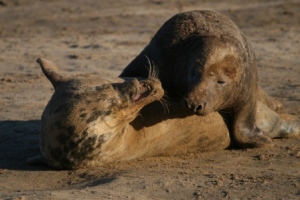Yesterday we celebrated Christmas seal shack style, the proceedings were much the same as for Thanksgiving only with Christmas pudding, crackers and “Elf” on TV. This week also marks the final week of fieldwork and we are all looking forward to a well earned break, in the meantime the research continues as normal.
I’ve mentioned before that I am researching female grey seals but I haven’t really discussed what my project entails, contrary to popular opinion I don’t just count seals. Sean’s most recently published research has shown that individual female seals can be classified into distinct behavioural types or ‘personalities’. Mothers with a “proactive” behavioural type have relatively inflexible behaviour and seem to stick to the same mothering behaviour whatever is happening around them in their regularly changing local environment (for example, how many neighbours a mother has, and who they are). These mums seem to have a play it safe approach, adopting a behavioural style that, in general, suits the typical conditions a mother is likely to encounter. By contrast, mothers with a “reactive” behavioural type were found to be much more flexible in their behaviour, allowing them to adapt their mothering style to suit their ever changing local environment, or at least attempt to. Sometimes they would get it right, and match their behaviour to suit their surroundings, and do relatively well in terms of raising their pups. However, this is a risky strategy, because if mums fail to match their behaviour to their changing environments, they seem to do rather poorly in terms of raising their pup. On balance though, both personality types are equally successful, while seals with a proactive type play it safe and do consistently well, those with a reactive type take a risk and may do very well or very badly.
Interestingly, the more adaptable reactive seals were found to be less aggressive than those with a proactive type. What’s more, there were differences in where the two behavioural types directed aggression. Reactive type seals tend to be more aggressive towards males than they are towards other females while proactive type seals are more aggressive towards other females. Why this should be is not yet clear; one possibility is that because proactive seals are the most aggressive they are able to fight off other females to gain access the parts of the colony occupied by the most desirable males. This means they would not need to fend off the unwanted advances of inferior males since all the males in their local area would be of high quality. For reactive seals the situation is reversed; because they are less aggressive they may tend to get pushed towards the edges of the colony where they are subject to harassment by low quality “transient” males leading to increased male-female aggression.
If correct this situation demonstrates that female grey seals are actively choosing their mates. While proactive females have little need to be choosy, reactive females appear to be actively fighting off males that do not interest them. My research is an investigation into this link between personality and mate choice. It’s still too early to say what I will find but after almost six weeks of fieldwork I hope to have some answers soon.



Pingback: Where are they now: The Bird is the Word | Studying Seals·